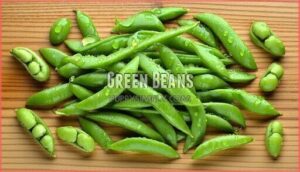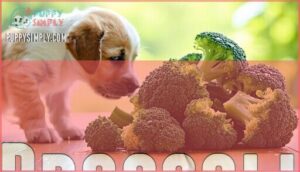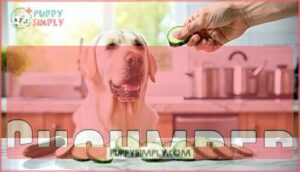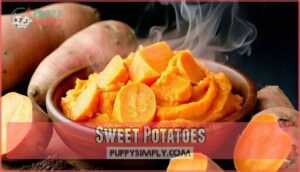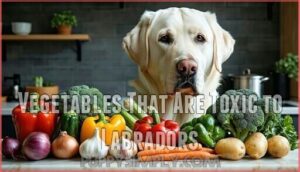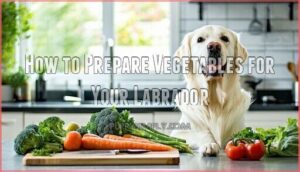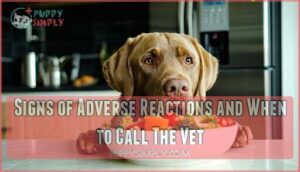This site is supported by our readers. We may earn a commission, at no cost to you, if you purchase through links.

Vegetables like carrots and green beans aren’t just crunchy treats—they slip real nutrition into your Lab’s bowl. Still, there are a few common options that can spell trouble if you’re not careful. Knowing which veggies boost health—and which ones to skip—makes all the difference for your loyal companion.
Table Of Contents
Key Takeaways
- Many vegetables are safe and healthy for Labradors in moderation, with options like carrots, green beans, broccoli, cucumber, sweet potatoes, and bell peppers offering real nutritional benefits.
- Toxic vegetables such as onions, garlic, wild mushrooms, and rhubarb should always be avoided, as even small amounts can cause serious health issues for your dog.
- Always wash, chop, and prepare vegetables simply—steaming or pureeing for easier digestion and removing seeds, pits, and tough peels to avoid choking or digestive problems.
- Introduce new vegetables gradually, watch closely for signs of digestive upset or allergy, and consult your vet for any concerning reactions or questions.
Can I Feed My Labrador Retriever Vegetables?
Thinking about adding more vegetables to your Labrador’s meals? It’s smart to check which ones are safe before making any changes.
Let’s take a closer look at what you can offer and what you’ll want to skip.
Are Vegetables Safe for Labradors?
While many vegetables are safe for Labradors when given in moderation, it’s important to know which ones make good snacks and which to skip. Some safe vegetables for dogs support dog health and offer valuable nutrients. Others can lead to vegetable allergies or nutritional deficiencies.
Knowing the difference between raw vegetables, cooked vegetables, and toxic vegetables for dogs is key.
Recommended Serving Size and Frequency
Once you know which vegetables are safe for your Labrador, the next step is figuring out how much and how often to offer them. Veggies should be a treat, not a main course. Limit them to about 10% of your dog’s daily calorie intake to support dog nutrition and avoid digestive upset. Keep moderation in mind by following these tips:
- Stick to treat alternatives rather than replacing meals.
- Adjust for breed differences and age consideration in your feeding schedule.
- Always introduce new vegetables slowly.
- Monitor calorie percentage from all treats, not just veggies.
- Follow dog dietary guidelines—every pup is unique.
Nutritional Benefits for Dogs
By focusing on moderation, you gain more than just a treat for your Labrador—you support dog nutrition from the inside out. Fiber digestion keeps their gut running smoothly, while vitamins and minerals fuel energy and growth. Many dog owners find that safe vegetables for dogs can be a beneficial addition to their pet’s diet.
Here’s what vegetables add:
| Benefit | Nutritional Value |
|---|---|
| Fiber Digestion | Better stool quality |
| Antioxidant Intake | Protects cells |
| Weight Management | Low-calorie satisfaction |
| Immune Support | Stronger defenses |
| Disease Prevention | Fewer chronic issues |
Which Vegetables Are Safe for Labradors?
You want to know which vegetables are safe to share with your Labrador. Let’s walk through the most common options you can offer.
Here are the ones you can feel good about giving your dog.
Carrots
Bite into the carrot advantage: Labradors often love the crunch, and you get a treat that cleans teeth while delivering great nutrition. Packed with beta-carotene, carrots support vision and immune health. For Labrador puppies and adults, aim for 50–70 grams, chopped and raw or lightly steamed. Carrots make following dog dietary guidelines easy. As detailed in a vet-approved guide, carrots are safe for canine consumption.
- Dental Health boost
- Beta-Carotene Benefits
- Simple Serving Suggestions
- Easy Carrot Preparation
Green Beans
A simple green bean adds more than a crunch—it brings fiber benefits and helps with weight control. Green beans are among the safe vegetables for dogs and can be served raw or cooked, plain and chopped.
Use the table below for easy reference on nutritional content and preparation methods for your Labrador’s dog nutrition and health.
| Green Beans | Raw vs Cooked | Preparation Methods |
|---|---|---|
| Fiber | Both safe | Washed and chopped |
| Low calorie | Prefer cooked | Steamed, plain, cut |
| Protein | Both options | No added salt |
| Vitamins | Raw or cooked | Serve plain |
| Iron | Both safe | Avoid spices, oils |
Broccoli
Broccoli is a powerhouse regarding nutrient content—think vitamins C and K, fiber, and antioxidants that support dog health and nutrition.
For serving suggestions, offer broccoli in small bites, steamed or raw, as a treat. While broccoli benefits most Labradors, larger amounts may cause tummy upset, so stick to moderation among safe vegetables for dogs and avoid any dangerous vegetables for dogs.
Cucumber
A cool cucumber offers real hydration benefits—especially useful during warmer months. Thanks to its high water content and low sugars, this vegetable is a safe food for overweight or diabetic dogs.
Always peel cucumbers first, slice into bite-sized pieces, and watch for choking hazards. Cucumber makes a healthy snack for dog health and nutrition; moderation is key.
Sweet Potatoes
Ever noticed how sweet potatoes are a favorite in many homemade dog recipes? Rich in fiber and vitamin A, these vegetables offer real nutritional benefits for your Labrador. Serve them cooked and plain—never raw or with added seasoning.
Here’s how to safely include sweet potatoes:
- Slice and steam or bake
- Mash for easy chewing
- Mix with kibble
- Limit portions
Bell Peppers
Think bell peppers are just for salad bars? Think again. Bell peppers, no matter the color, are a safe food for Labradors and offer immune boost benefits thanks to their rich vitamin content. Red peppers pack extra punch. Just remove seeds and stems to avoid digestive risks.
Serve raw or lightly cooked—bell peppers are a colorful way to enrich your dog’s diet.
Vegetables That Are Toxic to Labradors
Some vegetables may look harmless but can actually be dangerous for your Labrador. Even a small amount can lead to serious problems.
Let’s take a look at which vegetables you’ll want to keep out of your dog’s bowl.
Onions
Onion toxicity in Labradors is no small matter. Even a little—raw, cooked, or powdered—can lead to hemolytic anemia, damaging red blood cells.
Don’t be fooled by dog food ingredients or home-cooked meals; all forms are harmful. Smaller breeds suffer more, but no size is truly safe.
Regarding onions, all are foods to avoid for dogs.
Garlic
Just like onions, garlic is off-limits for Labradors. Garlic toxicity hits even harder—about five times as strong—and affects all breeds. Cooking doesn’t make it safe; even small bites harm your dog’s red blood cells. Want safer flavor?
- Never feed cooked or raw garlic.
- No “safe amounts” exist.
- Small breeds feel the impact faster.
- Watch for pale gums.
- Try parsley for seasoning instead.
Mushrooms
Garlic isn’t the only kitchen risk hiding in plain sight. Mushrooms, especially wild ones, can cause trouble fast for Labradors. Only a small portion of mushroom species are deadly, but guessing isn’t worth it. Symptoms—like vomiting or confusion—can show up quickly. Store-bought mushrooms are safer, but wild mushrooms? That’s a hard no for dog food safety.
| Risk | Wild Mushrooms | Store-bought Mushrooms |
|---|---|---|
| Toxic Species | Many | Few |
| Identification | Difficult | Labeled/controlled |
| Ingestion | Dangerous | Safer in moderation |
| Prevention | Avoid walks | Remove leftovers |
Rhubarb
You might picture rhubarb in a pie, but in your Labrador’s dish, it’s trouble. Rhubarb packs Oxalic Acid in its leaves, making it one of those vegetables dogs can’t eat.
This toxic food binds calcium in the blood and spells big dog health concerns: Kidney Failure, tremors, drooling, or worse. Even tiny bites risk poisoning symptoms—especially with leaf toxicity.
Asparagus Considerations
Compared to rhubarb, asparagus isn’t toxic, but that doesn’t mean you should toss it in your Labrador’s bowl without a second thought. Asparagus digestion can be tough on some dogs, so watch for:
- Upset stomach or vomiting
- Little nutritional value after cooking
- Stringy texture, hard to chew
- Safer, more appealing veggie options for dog digestion
Preparation methods matter too.
How to Prepare Vegetables for Your Labrador
Preparing vegetables for your Labrador is all about keeping things safe and easy to eat. There are a few steps you’ll want to follow every time. Here’s what to keep in mind next.
Washing and Chopping
Before you serve up veggies to your Labrador, think of the kitchen sink and cutting board as your pup’s first line of defense. Always rinse produce to reduce pesticide residue—your dog’s health depends on it.
Chop vegetables into bite-sized pieces; size matters for safe chewing. Use clean, safe utensils, avoid cross-contamination, and store prepared veggies properly. Prioritize pet safety every step.
Steaming Vs. Raw
When you’re choosing how to prepare veggies for your Labrador, it helps to know that the difference between steaming and serving them raw can really change how much your dog benefits from each bite.
Steaming softens fibers, improving digestibility and nutrient retention. Raw vegetables score on crunch and palatability, but some dogs struggle to digest them.
Each cooking method offers different benefits for dog nutrition and health.
Blending and Pureeing
Turning your dog’s veggies into a smooth blend or puree can make them much easier to digest, letting your Lab soak up more of those good nutrients with every meal. Blending cooked vegetables into puppy food or mixing them into meal-time are practical ways to support digestive health.
Pureeing offers a palatability boost—a win for picky eaters or older dogs with sensitive teeth.
Removing Seeds, Pits, and Peels
Think of seeds, pits, and tough peels like little landmines hiding in your dog’s food bowl—they’re best cleared away before your Lab digs in. Seed toxicity and pit hazards can lead to choking risks or stomach trouble. Even peels can be tough on dog digestion.
Safe food prep means removing these parts for truly safe, dog-friendly vegetables every time.
Signs of Adverse Reactions and When to Call The Vet
Bringing new foods into your Labrador’s diet is exciting, but it’s important to watch for any changes. Sometimes, even safe vegetables can cause a reaction.
Here’s what to keep an eye out for.
Digestive Upset and Allergies
Has your Labrador ever gobbled up something new and then spent the afternoon with a rumbling stomach? Even the healthiest veggie can cause digestive upset if introduced too quickly or in large amounts.
Watch for:
- Loose stools or diarrhea.
- Excessive gas after veggies.
- Itching or chewing paws.
A gradual introduction helps protect their gut microbiome and reduce reactions to common allergens.
Symptoms of Toxicity
Trouble can start within hours after toxic foods—a quick Onset Time often brings vomiting or diarrhea. Watch for Gastrointestinal upset, but don’t overlook Neurological Signs like tremors or confusion. Sudden Respiratory Distress or dark urine can warn of Renal Failure.
Mortality rates climb when signs are missed. In all serious Dog health concerns, time matters—call your vet immediately.
If you notice warning signs in your Labrador, act quickly—because delayed care can mean life or death
Monitoring After Introducing New Foods
Catching small changes in your dog’s habits or appetite after a new snack can make all the difference in keeping them healthy. Keep watch for subtle shifts—like Stool Changes, Digestive issues, or even Allergy Symptoms.
Appetite Changes, Behavioral Shifts, and low Hydration Levels are early warnings. Prompt action when you spot Diarrhea, Vomiting, or Gastrointestinal upset helps you stay ahead of serious trouble.
Consulting Your Veterinarian
If something just doesn’t feel right with your dog after trying a new veggie, reaching out to your veterinarian can give you peace of mind. A vet knows your Labrador’s breed specifics and can help with allergy testing, supplement advice, or issues around toxic foods.
They’ll craft custom nutrition plans so dietary changes keep your pet health and dog nutrition on track.
Frequently Asked Questions (FAQs)
Can vegetables help with my Labradors weight management?
Imagine your dog’s waistline as a measuring tape—veggies help keep it trim. Low in calories, high in fiber, and perfect for portion control, they offer healthy snack options and treat alternatives that support a balanced diet.
Are frozen vegetables safe for my Labrador to eat?
Frozen vegetables can be a safe addition to your dog’s diet. Look for options with no added seasonings or sauces. Thaw using cool water, not the microwave, to preserve freezing nutrients and prevent blanching impact. Watch for additives concerns.
Do vegetables affect my Labradors dental health?
Chewing crunchy vegetables works as a natural toothbrush for your dog, helping control tartar and giving gums a gentle massage.
It won’t replace regular brushing, but it’s a simple way to promote healthy dog breath and digestive health.
How can I encourage a picky Labrador to try vegetables?
Start with a gradual introduction, mixing familiar dog treat options or healthy snacks into vegetables. Try flavor pairings and texture variations your dog prefers. Use positive reinforcement.
Preparing vegetables for dogs well can help—and a vet consultation guarantees safety.
Is it safe to mix vegetables with commercial dog food?
Mixing vegetables with commercial dog food is generally safe if you pay attention to preparation methods and overall nutrient balance.
Always check for food allergies, adjust for dog food ingredients, and seek veterinary advice to avoid digestion concerns.
Conclusion
Picture yourself paging through an old cookery book—except this time, you’re deciding what’s best for your Labrador retriever. The old question, can I feed my Labrador retriever vegetables, isn’t just about greens; it’s about giving your companion a richer life.
Every healthy bite is a step toward vitality, while a little caution keeps tails wagging. Trust your instincts, watch closely, and share the good stuff. When your Lab thrives, it’s proof you’ve chosen wisely for both of you.
- https://www.petpoisonhelpline.com/pet-tips/wild-mushrooms-and-dogs/
- https://pupford.b-cdn.net/assets%2Fblog%2F39VegetablesandFruitsDogsCanandCantEat%2F1603142198969-39-Fruits-and-Vegetables-Dogs-Can-and-Cant-Eat-Printable-Fridge-Graphic.pdf?alt=media&token=638b6aea-cfb0-48f5-9123-e074dbbd6158
- https://shrsl.com/3gl5u
- https://pupford.com/
- https://thenaturaldogstore.com/blogs/health/vegetables-for-dogs


